 |
 |
 |
http://www.varalaaru.com A Monthly Web Magazine for South Asian History [187 Issues] [1839 Articles] |
 |
 |
 |
http://www.varalaaru.com A Monthly Web Magazine for South Asian History [187 Issues] [1839 Articles] |
|
Issue No. 121
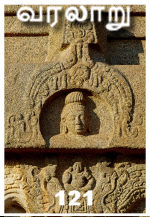
இதழ் 121 [ ஜுலை 2015 ] 
இந்த இதழில்.. In this Issue.. 
|
The Second Prakara The second prakara has a gopura entrance. The gopura is a two tier structure raised on a upapitha. It is sectioned as karna patthis in the corners and sala patthi in the middle. On the either side, Dvarapalas adorn the niches formed in between the karna and sala patthis. Above the upapitha is the padabandha adhishthana, the wall above the adhishthana is adorned by brahmakanta pilasters. In between the wall and the adhishthana is the vedika complex with usual elements. The pilasters carry upper ornamentation of kalasa, tadi, kudam, pali, palakha and virakanda. The vettu potikas above the pilasters extend the limbs to bear the uttira. Above the uttira is the vajana, valabhi and kapota. The valabhi is ornamented as padma series. The kapota is adorned with kudu at frequent intervals. Above the kapota is the bhumidesa denoting the end of the tala. The super structure is rich in stucco figures depicting the various puranic themes. 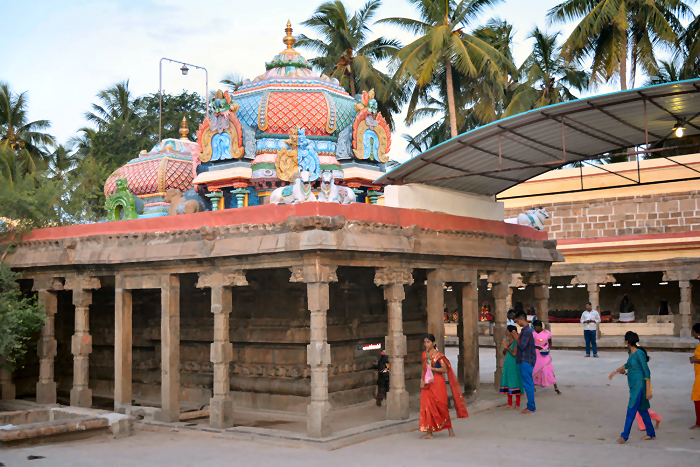 Main Vimana Above the vedika is seen the hara of the first tala. It consists of the kutas in the corners and sala in the middle. The harantara connects the hara elements, besides kshudra nasikas seen in the harantara. All these elements have stucco figures in their nasikas. The harmaya of the second tala raises behind the hara. The wall of the harmaya is sectioned by brahmakantha pilasters and the potikas are angular. The prastara includes the usual elements and the valabhi is decorated with equidistantly placed madalai. The overhanging kapota has kudu arches. The bhumi desa is represented by a short wall. The vedika rests on the roof of the harmya of the second tala has ganas and the vahanas in all the four corners. The wall of the griva has brahma kantha pilasters in all the corners that support the usual prastara elements. The valabhi is adorned with madalai. The griva has four mahanasikas facing the cardinal directions and four more as alpa nasikas, two on the east and two on the west. On the eastern side, either side of the mahanasikas are depicted with Dvarapalas. Vinayaka and Muruga are shown in the alpa nasikas. The mahanasika on the north and south has Brahma and Dakshinamurthi respectively. The mahanasika on the west is empty. All the four corners possess a gana in the middle flanked by Nandi. The Sala shikara crowns the gopura and has a row of stupis in its summit. The compound wall extends on both the sides and encompasses the prakara. The entrance in the gopura leads to the inner prakara. Inside, in the centre of the prakara lies the shrine of Thirunedungala nathar, in the southwest corner of the prakara lies the Valamburi Vinayagar shrine facing east, in the northern side of the prakara lies the shrine of Agasthiya Linga facing east and the Chandeswara shrine facing south. A well called Agasthiya thirtha lies near the Chandeswara shrine. Except eastern side, the thiruchurru malika runs in all directions along the compound wall. 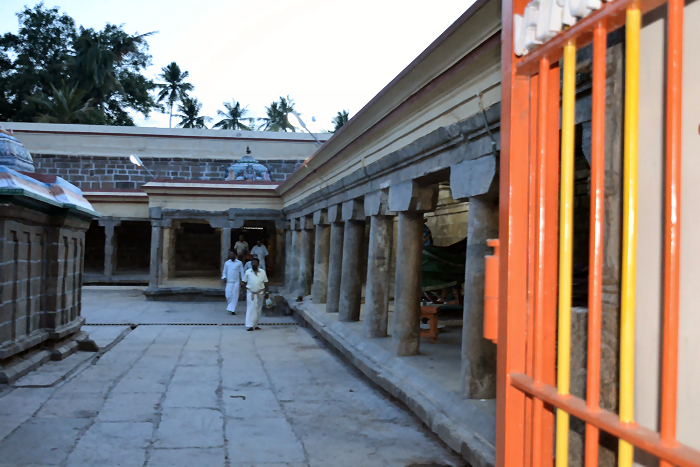 Tiruchutru-North Side 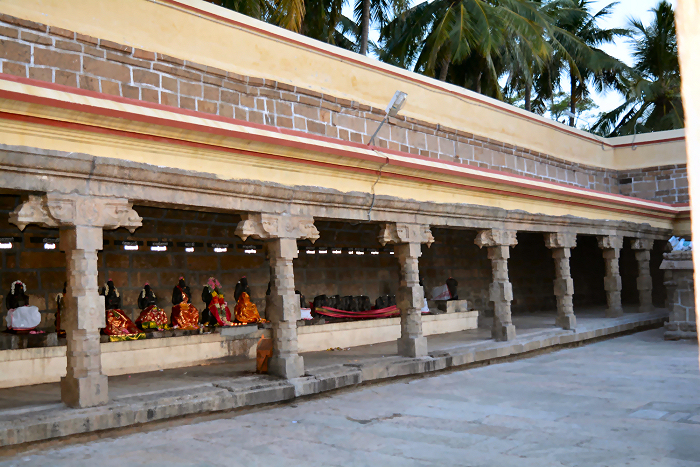 Tiruchutru-South Side The thiruchurru malaika has a upapitha with a row of pillars in the periphery. On the western side the thiruchurru possess two rows of pillars. The pillars on the northern side are rudra, whereas the pillars on the western and southern side are sectioned as three squares with kattu in between. In addition the pillars on the southern side are further ornamented with a band in the middle of the kattu and padmakattu flanking the squares. The potikas above the pillars on the north and the west are vettu whereas the potikas on the southern side are madalai and nunudal. The potikas bear the uttira and above the uttira is the vajana and valabhi. Stone slabs cover the roof of the thiruchurru and also finished with cement plastering. Sculptures of Chandeswara, Virabhadra, Saptamatas, Ganesa, and a panel of Saptamatrikas are seen on the southern side of the perambulation. The Subrahmania shirne is located on the western side in the thiruchurru. Besides, sculptures of Siva and Parvathi, Linga, Ganesa and few broken sculptures are kept here. In the north western corner of the thiruchurru is seen the shrine of Sri Varadharaja Perumal. Next to the shrine is seen the sculpture of Jeyeshta. Various vahanas are kept on the northern side of the thiruchurru. 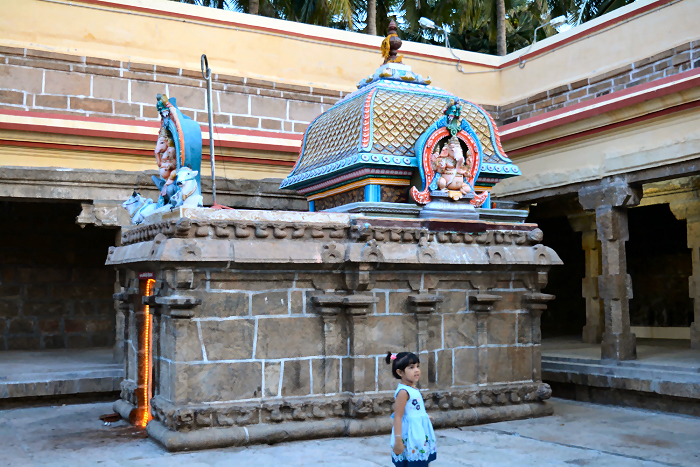 Valampuri Vinayagar Shrine The Valamburi Vinayagar Shrine The Valamburi Vinayagar Shrine consists of a vimana and a mukhamandapa. The vimana is a single tier structure with an adhishthana, bhitti, prastara, nagara sikhara and stupi. It has pratibandha adhishthana in which only the rudra kumuda and the prati series alone visible, the rest are inhumed in the later paved stone flooring. In the yazhi series the corners are adorned with makara heads. The wall is sectioned by brahmakantha pilasters. The pilasters possess upper ornamentation of kattu, kalasam, tadi, kudam, pali, palakha and virakantha. The potikas above the pilasters are angular and bear the uttira. Above the uttira is the vajana, valabhi. The flexed over hanging kapota possess kudus at frequent intervals. Above the kapota is the bhumidesa denoting the end of the tala. The griva and sikhara rests on the vedika. The griva has brahmakantha pilasters at the corners bearing the usual prastara elements. Instead of mahanasikas, the kirti mukhas are seen on all the sides except east and adorned with Ganesa in seated form. Above the sikhara is the stupi. The mukha mandapa carry the same segmentation as seen in the tala of the vimana. On the roof of the mukha mandapa Ganesa is shown inside an arched niche above the entrance and flanked by Nandi. The sanctum houses Lord Ganesa seated on a pedestal in lalitasana, the back hands carry pasa and angusa and the front hands carry tusk on the right and motaka on the left. The God is adorned with karanda makuta, ornaments and short attire. The Agatthiyar Linga shrine The Agatthiyar Linga shrine consists of a sanctum and a mukha mandapa. The sanctum has padabandha adhishthana, wall sectioned by brahmakanta pilasters and vettu potikas rest above the pilasters. The potikas bear the prastara components of uttira, vajana and valabhi. The flexed overhanging kapota, nagara sikhara and stupi are of modern origin. Griva, the important component of a vimana is absent in the structure. The sanctum houses a Linga and the mukha mandapa, a Nandi. 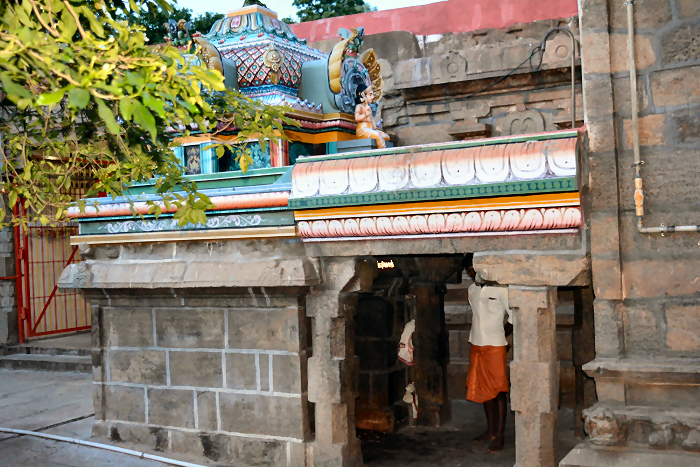 Chandeswara Shrine The Chandeswara Shrine The shrine consists of a sanctum and a pillared mukha mandapa. The sanctum has a basement, wall, prastara, griva, sikhara and stupi. The usual segmentation in the adhishthana is absent and the wall possesses brahmakanta pilasters in the corners. Again the potikas are absent. Uttira, vajana, valabhi and kapota are the prastara components seen. Flexed over hanging kapota also possess kudu arches and scrolls in the corners. Above the kapota runs the bhumi desa. The vedika, griva, nagara sikhara and stupi are of modern origin. The griva has brahmakantha pilasters at the corners supporting the prastara elements. The mahanasikas are empty. The mandapa is a pillared hall. The pillars possess the features of three squares and kattu in between. The potikas above the pillars are vettu and taranga. The roof of the mandapa is covered with modern plastering. The sanctum houses Chandeswara seated on a pedestal in suhasana with the right hand carrying the axe and the left hand rested on the left thigh. 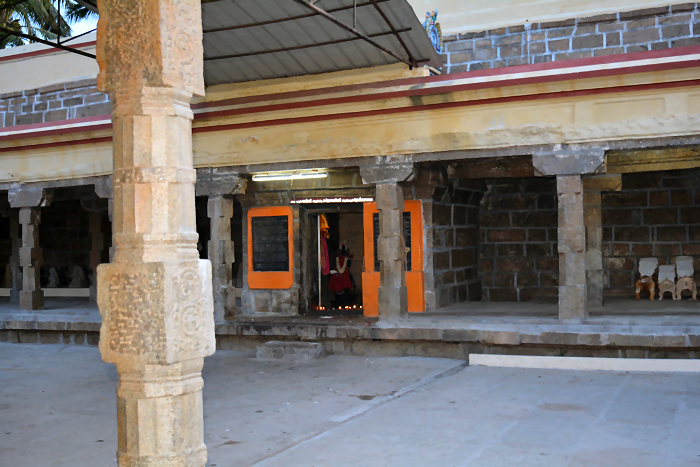 Subrahmanya Shrine The Subrahmania Shrine It is a sanctum alone shrine formed inside the thiruchurru malika with stone blocks arranged on both sides and the prakara wall forms the back wall of the shrine. The prastara components of uttira, vajana, valabhi and kapota are present. The shrine is crowned with dravida sikhara which is of modern origin. The sanctum houses Lord Subhramania with his consorts Valli and Deivanai. The God is standing in sama on a upapitha with his front hands in abhaya and varada and the back hands carry sakthi and vajra. He is decked in silk dress, ornaments, karandamakuta and chenni. Peacock, his vehicle is shown standing behind the God. The Goddesses are standing on a upapitha decked in silk dress, ornaments and carry flowers in their inner hand. 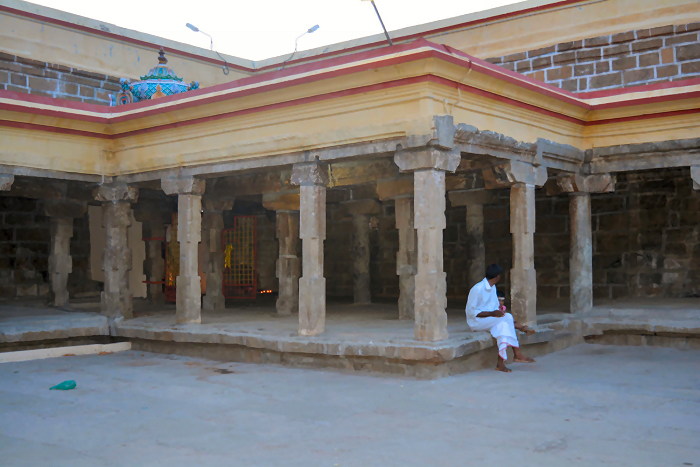 Varadaraja Shrine The Varadaraja Perumal Shrine The thiruchurru wall forms the back wall of the shrine and the side walls are of brick construction. The shrine has newly constructed dravida sikhara. The sanctum houses Vishnu with his consorts Sridevi and Bhudevi. The deities are seated on a separate pedestal in suhasana. Vishnu is carrying sangu and chakra on the back hands and the front hands are in abhaya and varada. The Goddesses are carrying flower in their inner hand and their outer hand in rested on their thigh. All the deities are decked in krita makuta, pattadai and ornaments. 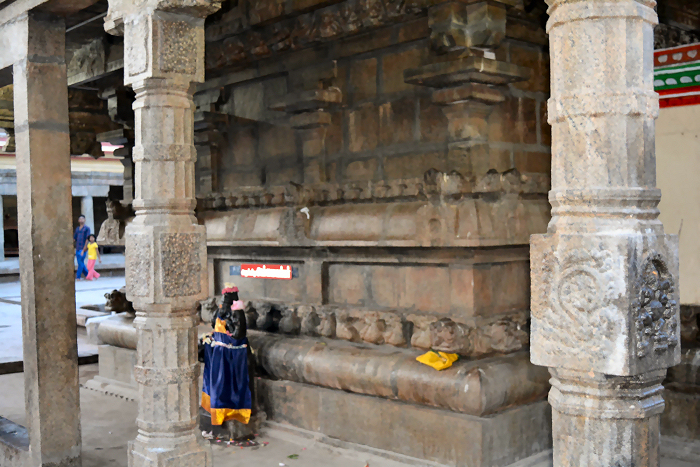 Main Vimana-Another view The Main Shrine The main shrine consists of a vimana, ardha mandapa, mukha mandapa and a maha mandapa. The Vimana and the ardhamandapa are encompassed by a pillared enclosure on the west, north and south which adjoins the wall of the mukha mandapa on either side. The encompassing pillars are sectioned as squares at top, bottom and middle. In between the squares are the kattu with a band in the center of the body. The pillars are further ornamented with kattu above the squares. Some of the squares carry miniatures, scrolls or medallions. The potikas are madalai and nanudal. The potikas bear the uttira, vajana and valabhi. Stone slabs are arranged connecting the sanctum and the pillars forming the roof of the space between the sanctum and the pillars. The roof has the extension of flexed overhanging kapota with kudu arches decorating its face. Bhumidesa with makara heads at the corners run above the roof. On the roof, pair of stucco Nandis are placed in the corners. The vimana is nagara type with dravida sikhara. It has a kapotabandha adhishthana that rests on an upana which is formed as inverted padma. Above the upana is seen the jagati, rudra kumuda, prativari, gala complex and kapota. All the said components of the adhishthana are heavily formed. Another row of prativari is shown above the kapota. Comparing the lower one the upper frieze is small and in the upper frieze the yazhis are paired whereas in the lower frieze their head facing same direction. Both the friezes possess makara heads at the corners. Upari kampa is seen above the upana and also above the gala complex. The gala complex possesses the components of kantha with pada flanked by kampa. The kapota is ornamented with kudu arches and konapatta. The arches were formed out of the flow from the mouth of the kirti mukhas in the yazhi frieze. It is interesting to note that the vimana has a stunted wall which is cantoned by brahmakantha pilasters, the shaft simply of 0.10mts. Padmakattu, kalasa, tadi, kudam, pali, palakha forms the capital components of the pilasters. Virakantha, the uppermost component of the pillar bear the potikas which are vettu and taranga. The limbs of the potikas bear the uttira, vajana and valabhi. The valabhi is adorned with bhuta vari and yazhis at the corners. The flexed overhanging kapota possess kudu arches and chandra mandalas at the ridges. Above the roof is seen the vedika on which lies the griva and sikhara. The octagonal griva has brahmakantha pilasters that bear the uttira, vajana and valabhi. The valabhi is adorned with madalai at frequent intervals. The mahanasikas are shown on the four cardinal directions and crowned with kirti mukhas. All the mahanasikas are empty. The alpa nasikas are marked by kirti mukhas but rectangular lower component are absent. Above the sikhara is the stupi. Apart from the stucco Nandis, four stone Nandis are seated at four corners. The ardha mandapa carry the same segmentation of the vimana. In addition, above the roof of the ardha mandapa is seen a nagara sikhara adorned by kirti mukhas on all sides, but lack griva. Above the sikhara is the stupi. The mukha mandapa has a pratibandha adhishthana with octagonal kumudha. The wall of the mandapa is sectioned by brahmakantha pilasters which carry the usual upper ornamentation. The potikas are vettu-taranga and supports the usual prastara components. The valabhi is adorned with bhuta vari and the kapota with kudu arches. The bhumi desa run above the kapota. The bhuta mala is an interesting feature to note. The ganas are depicted frisking and frolicking; some are carrying instruments like lute, harp, cymbal, chirattai, some are with the gesture of dancing, one of the gana is seen closing its left eye with its left hand, one of the gana is seen stretching its mouth by its hands. The ganas in loin wear and also decked with ornaments like bangles, armlets, udarabanda, kundalas. The Mandapas The maha mandapa is a pillared hall extending upto the prakara wall in the east, north and south formed as a closed enclosure. It has opening in the north and the south to reach the perambulation of the prakara. On the northern side of the mandapa is seen the Navagraha, Bhairava shrine and a Bhairava sculpture. Surya and Chandra are seen flanking the entrance. Palliyarai, Nataraja-Sivagamasundari sanctum are seen on the northern side of the mandapa. On the southern side of the mandapa is seen the kitchen adjoining the compound wall facing west. The Nalvar is seen on the south-eastern side placed on a platform in the thiruchurru facing north. The pillars in the mandapa are of two types, rudra and squares-kattu. As like, the potikas are either vettu-taranga or madalai-nanudal. The maha mandapa leads to the mukha mandapa, Dvarapalas flanks the entrance. The pillars are sectioned as squares at the top and bottom with Vishnu kattu in the middle. The potikas above the pillars are vettu and taranga and bear the uttira. Above the uttira is the vajana, valabhi and stone slabs are arranged to cover the mandapa roof. A Nandi is seen in the center of the mandapa facing the sanctum. On the northern side of the mandapa is seen the closed enclosure where bronze sculptures of Somaskantha, Siva, Muruga with his consorts, Nandi are kept. The mukha mandapa leads to the ardha mandapa, a small chamber. In the entrance of the chamber is seen the Dvarapalas. The sanctum houses Lord Siva in the form of Linga. It is believed that the God is slightly oriented towards right to accommodate Goddess in the sanctum. Hence a sikhara is shown above the ardha mandapa. 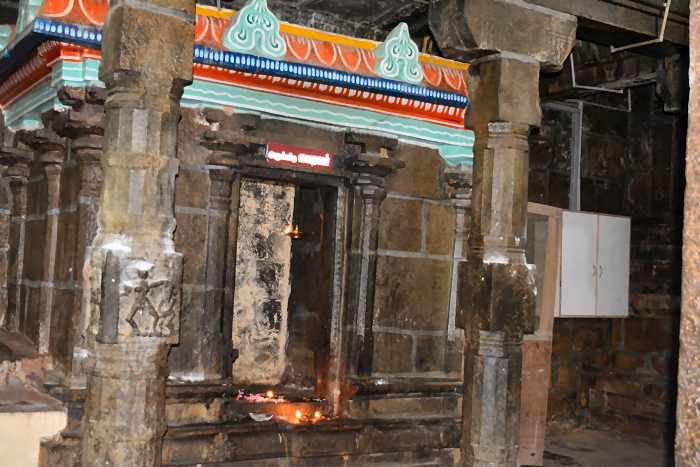 Bhairava Shrine The Bhairava Shrine The Bhairava shrine is on the north-eastern side of the maha mandapa formed adjoining the prakara wall and facing west. It has an adhishthana, bhitti and prastara. The adhishthana is kapotabandha and the wall sectioned by vishnukantha pilasters with usual capital components. In between the wall and the adhishthana is seen the vedika complex. The potikas above the pillars are vettu and taranga. The prastara is of modern origin includes the uttira, vajana, valabhi and kapota. The sanctum houses Bhairava standing in nude form with a dog behind. (to be continued...) |

சிறப்பிதழ்கள் Special Issues 

புகைப்படத் தொகுப்பு Photo Gallery 
|
| (C) 2004, varalaaru.com. All articles are copyrighted to respective authors. Unauthorized reproduction of any article, image or audio/video contents published here, without the prior approval of the authors or varalaaru.com are strictly prohibited. | ||